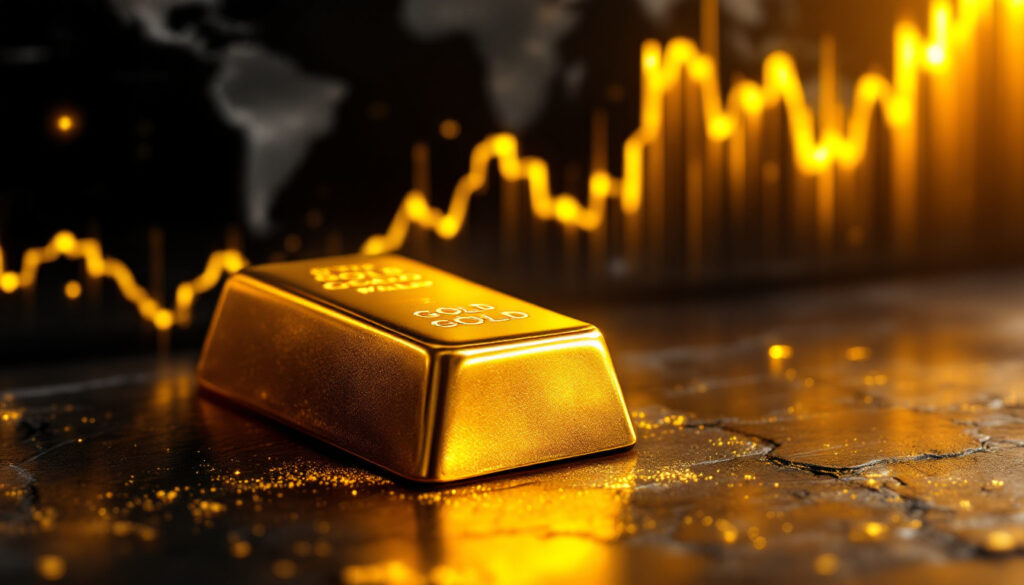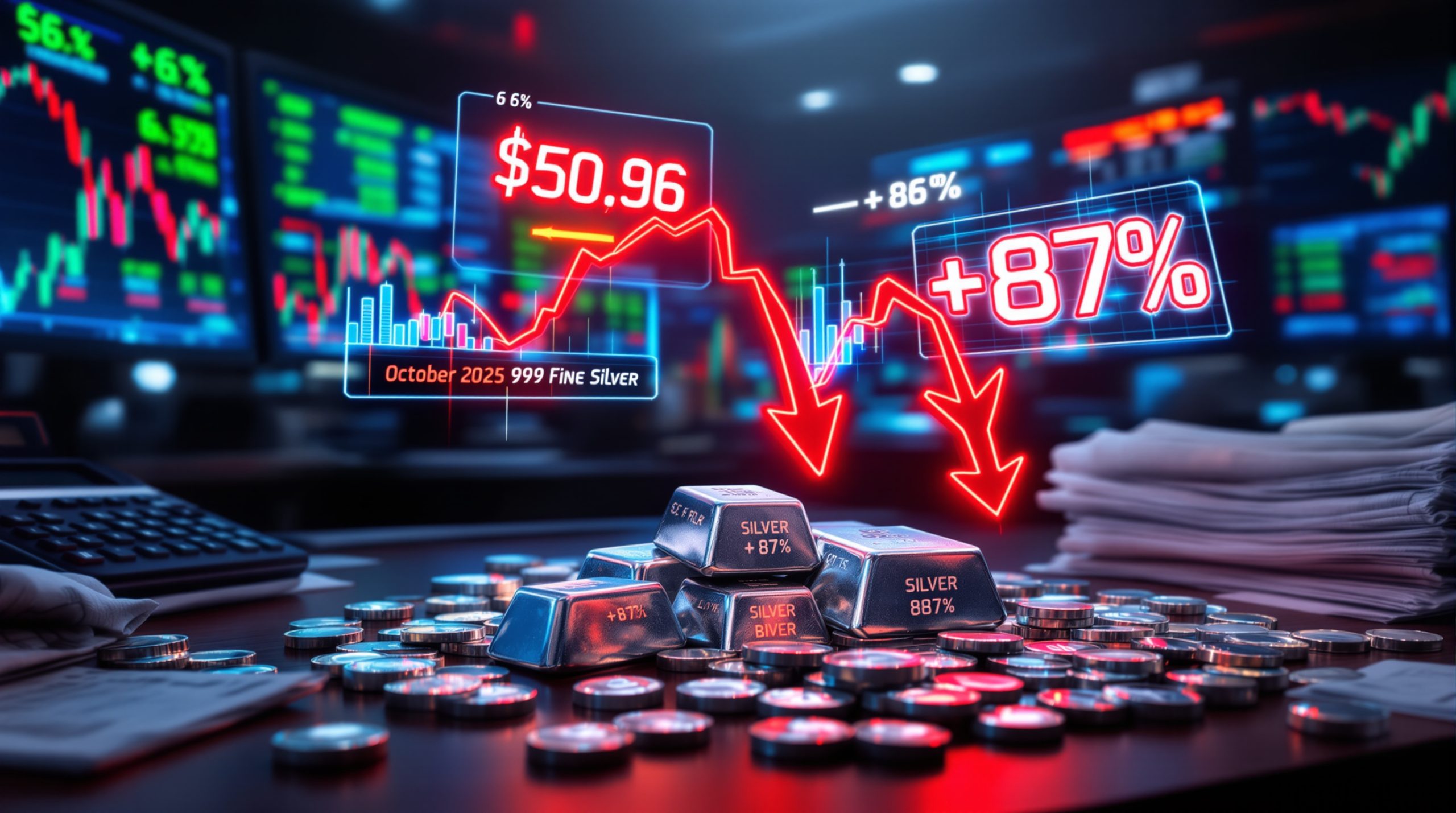What Drives Gold's Price Performance?
Safe Haven Demand as a Primary Catalyst
Gold has demonstrated remarkable price strength recently, reaching $3,330.70 with a significant single-day increase of nearly 2.75% (approximately $90). This surge highlights gold's enduring role as the premier safe haven asset during periods of economic uncertainty. Institutional investors, central banks, and individual buyers consistently turn to gold when geopolitical tensions rise or economic indicators weaken.
The precious metal's appeal intensifies during times of market stress, with investors seeking tangible assets that have historically preserved wealth through economic cycles. Unlike paper currencies or digital assets, gold's role as a hedge contributes to its perception as a reliable store of value when other investments falter.
Dollar Weakness Correlation
The U.S. dollar index sitting at 99.8 (below the psychological 100 mark) has significantly contributed to gold's price appreciation. This dollar weakness makes bullion more affordable for international buyers using other currencies, while simultaneously raising the dollar-denominated price.
The inverse relationship between gold and the dollar remains a fundamental market dynamic. When the dollar weakens against other major currencies, gold typically strengthens as international buyers can purchase more with the same amount of their local currency. This relationship has held consistent throughout economic cycles, with correlation studies showing a negative coefficient of approximately -0.4 to -0.6 between dollar strength and gold prices and safe haven demand.
Central Bank Accumulation
Central banks worldwide have been aggressively stockpiling gold reserves, providing substantial price support. Unlike silver, gold is universally recognized as a tier-one asset by financial institutions and central banking authorities, making it the preferred store of value for national treasuries seeking to diversify away from traditional currency reserves.
This institutional demand has created a consistent buying pressure in the market. Central banks added approximately 1,136 tons of gold to their reserves in 2024, representing a 15% year-over-year increase. China, Russia, and several emerging market economies have led this trend, reducing their exposure to dollar-denominated assets while increasing precious metals holdings.
Why Is Silver Lagging Behind Gold?
Industrial Metal Classification Challenges
Silver's price performance has been notably weaker than gold's, rising just over 1% to $32.42 during the same period that saw gold jump 2.75%. This divergence stems largely from silver's dual identity as both a precious metal and an industrial commodity. While gold is primarily valued for wealth preservation, silver's price is significantly influenced by industrial demand forecasts.
Over 50% of silver demand comes from industrial applications, including electronics, solar panels, and medical devices. This industrial dependency creates a fundamental difference in how markets value silver compared to gold, particularly during economic slowdowns when manufacturing and construction activities decline.
Economic Slowdown Concerns
Recent economic data points to potential industrial demand challenges for silver:
- U.S. economy contracted 0.3% in the first quarter
- China's manufacturing PMI fell to a 16-month low
- Chinese export orders experienced their largest drop since 2022
These indicators suggest weakening industrial activity, which directly impacts silver demand projections and creates downward price pressure that partially offsets safe haven buying. The manufacturing slowdown particularly affects silver-intensive industries like electronics and automotive, where silver is used in circuit boards, connectors, and electrical contacts.
Gold-to-Silver Ratio Implications
The gold-to-silver ratio has expanded to 103.08, indicating that one ounce of gold can purchase over 103 ounces of silver. This ratio significantly exceeds historical averages of 60-80, suggesting either silver undervaluation or a fundamental shift in how markets view these metals relative to each other.
Precious metals investors often monitor this ratio for potential reversion opportunities. Historically, when the ratio exceeds 80, it has eventually returned toward the mean, creating opportunities for investors to exchange gold for silver. However, persistent structural changes in demand patterns may sustain higher ratios longer than historical precedents would suggest.
How Do Monetary Policies Affect Precious Metals?
Federal Reserve Rate Decisions
The Federal Reserve has maintained its policy rate at 4.25-4.5% since December, with markets closely monitoring upcoming Federal Open Market Committee meetings for signals about the future interest rate trajectory. Gold typically thrives in low interest rate environments, which explains part of its 26% price appreciation year-to-date.
When interest rates remain stable or decline, the opportunity cost of holding non-yielding assets like gold decreases. This relationship has been particularly evident in recent years, as periods of monetary accommodation have coincided with strong precious metals performance. Furthermore, US Fed rate effects on gold prices remain a critical factor for investors to monitor.
Interest Rate Sensitivity Differences
Gold and silver respond differently to interest rate expectations:
- Gold tends to perform better during rate cut cycles and periods of negative real rates
- Silver's performance is more mixed, as lower rates can stimulate industrial demand while also enhancing its monetary appeal
- The timing and pace of potential rate cuts will likely influence the relative performance of both metals
A 1% reduction in interest rates could potentially boost silver prices by 15% if accompanied by improved industrial demand forecasts. However, without supporting economic growth, rate cuts might primarily benefit gold through its monetary characteristics rather than driving significant silver appreciation.
Inflation Protection Characteristics
Both metals serve as inflation hedges, but gold has historically demonstrated stronger correlation with inflation expectations. As monetary policy shifts toward potential easing, investors are positioning for possible inflationary consequences, benefiting gold disproportionately compared to silver.
With core inflation currently at 3.4%, concerns about currency devaluation continue to drive investment in precious metals. Gold's millennia-long history as a store of value during inflationary periods reinforces its appeal when monetary expansion threatens purchasing power.
What Geopolitical Factors Are Influencing Precious Metals?
Trade Tensions and Tariff Concerns
Recent announcements of potential 100% tariffs on foreign-made films have reignited concerns about escalating trade tensions between major economies. These developments have contributed to market uncertainty, driving investors toward safe haven assets.
While China's commerce ministry has acknowledged U.S. proposals to restart trade talks, the lack of concrete meeting plans between leadership has maintained an atmosphere of uncertainty. This geopolitical friction typically benefits gold prices and safe haven demand more than silver, as investors seek protection from currency volatility and market disruptions.
Regional Monetary Initiatives
Several U.S. states are exploring gold-backed monetary systems, with some establishing bullion depositories and others considering partial gold standards. These initiatives reflect growing interest in precious metals as monetary anchors and could potentially increase institutional demand for physical gold.
The Texas Bullion Depository represents a tangible example of this trend, serving as a secure storage facility for state-owned precious metals. These developments could increase annual institutional gold demand by 10-15% if widely adopted, creating additional price support.
Global Economic Power Shifts
Changing economic relationships between major powers have led to diversification away from traditional reserve currencies. This transition has benefited gold particularly, as nations seek to reduce dependency on any single currency while maintaining liquid reserves with intrinsic value.
Central banks in emerging economies have accelerated their pace of gold accumulation, reflecting a strategic shift in reserve management policies. This institutional buying creates consistent demand that helps establish price floors during market corrections.
What Investment Strategies Work in Current Market Conditions?
Dollar-Cost Averaging Approach
For investors looking to build precious metals positions, dollar-cost averaging remains an effective strategy during volatile price movements. This approach involves making regular purchases regardless of price, though investors might consider reducing allocation amounts during significant price increases to optimize overall entry points.
A practical implementation might involve trimming gold purchases when prices exceed $3,300 while increasing silver allocations when prices fall below $32. This flexible approach allows investors to maintain disciplined buying while responding to market conditions.
Portfolio Allocation Considerations
The current gold-to-silver ratio of 103.08 presents potential opportunities for strategic allocation decisions:
- Conservative investors might favor gold for its stronger institutional support (70% allocation)
- Value-oriented investors might find silver's relative underperformance attractive (higher silver weighting)
- Diversification across both metals can balance monetary and industrial exposure
A balanced precious metals allocation typically represents 5-10% of an investment portfolio, serving as a hedge against currency devaluation and market volatility while providing potential appreciation. For those interested in other investment vehicles, gold ETFs strategies offer additional diversification options.
Physical vs. Paper Investment Options
Investors can choose between physical metal ownership and various financial instruments:
- Physical bullion offers direct ownership without counterparty risk
- ETFs like SPDR Gold Shares (GLD) provide convenient exposure without storage concerns
- Mining stocks such as Newmont Corporation offer operational leverage to metal prices
- Futures contracts allow for sophisticated trading strategies
Each approach offers different risk-reward profiles and liquidity characteristics. Physical ownership eliminates counterparty risk but requires secure storage, while paper investments offer convenience but introduce potential third-party risks.
How Might Market Conditions Evolve?
Economic Indicator Watchpoints
Key economic indicators that may influence precious metals prices include:
- Manufacturing PMI readings from major economies
- Unemployment (currently 3.9% in the U.S.) and wage growth statistics
- Inflation data (Eurozone: 2.8%), particularly core measures
- GDP growth rates across developed and emerging markets
A 0.5% Federal Reserve rate cut could potentially lift gold prices to $3,500 as investors reposition portfolios to accommodate changing monetary conditions. In addition, keeping track of gold market analysis can provide valuable insights for future price movements.
Central Bank Policy Trajectories
The pace and timing of potential interest rate adjustments will significantly impact precious metals performance. Markets currently anticipate rate cuts, but the schedule and magnitude remain uncertain, creating both opportunities and risks for metals investors.
The European Central Bank's increasingly dovish stance may further weaken the euro against the dollar, potentially boosting dollar-denominated gold prices. Meanwhile, delayed rate cuts could put temporary pressure on silver prices until industrial demand recovers.
Supply-Demand Balance Shifts
While silver currently faces industrial demand concerns, supply constraints remain a factor for both metals:
- Silver's structural deficit reached approximately 4,200 tons in 2024
- Gold mine production has stagnated around 3,500 tons annually
- Recycling volumes fluctuate with price movements
- Above-ground inventories continue to shift from weak to strong hands
The silver market could tighten significantly if solar panel demand rebounds, potentially narrowing the gold-silver ratio to 85:1 from current levels. Investors should also monitor gold and silver trends for changes in this relationship.
FAQ: Gold and Silver as Safe Haven Assets
What makes gold a stronger safe haven than silver?
Gold's superior safe haven status stems from its universal recognition by central banks as a tier-one asset, limited industrial applications that reduce economic sensitivity, and thousands of years of historical precedent as a monetary metal. Approximately 56% of silver demand comes from industrial applications, making it more vulnerable to economic cycles than gold.
Additionally, gold's higher value density makes it more practical for large-scale wealth preservation compared to silver. A million dollars in gold weighs approximately 17 kilograms, whereas the same value in silver would weigh over 1,700 kilograms, creating significant storage and transportation challenges.
How do interest rates affect gold and silver prices?
Lower interest rates generally benefit precious metals by reducing the opportunity cost of holding non-yielding assets. When real interest rates (nominal rates minus inflation) turn negative, gold typically outperforms most other asset classes, as evidenced by its 26% surge in 2024 amid expectations for monetary easing.
Silver benefits from this dynamic as well, but its industrial component means economic growth considerations can sometimes counteract monetary factors. Historically, silver performs best when accommodative monetary policy coincides with strong industrial demand—a combination that maximizes both its monetary and industrial characteristics.
Should investors be concerned about the widening gold-to-silver ratio?
The gold-to-silver ratio at 103.08 is historically elevated, suggesting potential relative value in silver. However, this ratio may remain elevated if institutional demand for gold continues to outpace silver's mixed industrial and monetary demand profile.
Historically, ratios above 100 have eventually reverted toward their mean, presenting opportunities for strategic metal swaps. However, prolonged central bank gold accumulation could delay this reversion, maintaining higher ratios for extended periods. Diversification across both metals helps mitigate timing risks associated with ratio trading strategies.
How might central bank digital currencies affect precious metals?
The development of central bank digital currencies (CBDCs) could either threaten or enhance precious metals' monetary role. While CBDCs might offer convenience that physical gold lacks, they also raise privacy concerns and potentially increase demand for non-governmental stores of value like precious metals.
CBDCs and gold could coexist in complementary roles, with digital currencies facilitating transactions while precious metals serve as long-term stores of value outside the digital financial system. The increased transparency of digital money might actually increase demand for private, portable wealth preservation options like gold and silver.
Ready to Capitalise on the Next Major Gold or Silver Discovery?
Discover how investors can gain immediate alerts on significant ASX mineral discoveries with Discovery Alert's proprietary Discovery IQ model, turning complex data into actionable insights for both precious metals and beyond. Understand why historic discoveries generate substantial returns by exploring Discovery Alert's dedicated discoveries page and position yourself ahead of the market.




